By C.M.
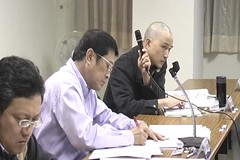
Chairs Wu Hung, Yang and Dai (from
right to left).
At a preparatory hearing held on Monday 24th March in Wufeng Township, Taichung County, it was decided that the official public hearing concerning conservation measures to accompany the Hushan Reservoir project in Yunlin County, originally scheduled for the following Monday (31st March), would be postponed. Yesterday the Water Resources Agency (WRA) announced that the meeting will now be held on Saturday 26 April.
The purpose of the official hearing is, according to the WRA, to allow explanation of the current state of the Hushan Reservoir Ecological Conservation Measures, the design and implementation of which were one of the conditions upon which the project was approved.
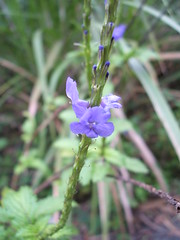
The decision to postpone the meeting was made when it became clear during the preparatory hearing that the developer (the Central Region Water Resources Office (CRWRO)1) would, within the remaining time, be unable to pull together the answers to many of the questions to be posed at the official hearing by those concerned about the project’s negative environmental and social impacts.
The hearing, chaired by Dai Siousyong (戴秀雄)2, Yang Weifu (楊偉甫)2 and Wu Hung (朱增宏)3, aimed to negotiate the procedure for the official hearing and to clarify the points of contention to be discussed at the official hearing.
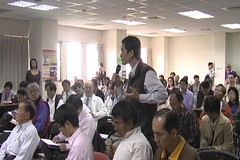
Chen Ching-Chun of Taiwan Academy of
Ecology describes potential impacts on
the Cingshuei River.
During the hearing, it was clear that there was disagreement as to what should be up for discussion. While some participants expressed a desire to address the irreplaceability of Youcing Valley, which will be flooded if the reservoir is completed, others argued that the matter of Youcing Valley had already been discussed during Environmental Impact Assessment (EIA) proceedings and that it was too late to readdress it at this stage.

Mr. Lai of the WRA responds to questions.
The presentation by He Dong-ji (何東輯), head of the Habitat Ecology Division of Taiwan Endemic Species Research Institute (TESRI), provoked a similar response from academics and conservationists as was heard after the NGO site visit on March 3. One major criticism was that the lack of baseline data meant that the planners lacked an understanding of the original ecology of transplanted trees, rare plants and captured animals, and that they were therefore unable to choose suitable locations. This, it was argued, was demonstrated by their choice of a dry patch of land for restoration work, in contrast to the wet environment from which rescued species had been removed.
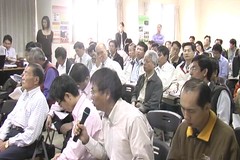
Professor Yang Kuo-Jheng of Taiwan
Academy of Ecology explains the
need for baseline data.
The lack of consideration of impacts on sand and sediment flow in the Cingshuei River, from which water is to be diverted to the Hushan Reservoir, was also criticized.
In addition, numerous other points were raised including the failure to consider alternatives to the Hushan Reservoir project for dealing with perceived water needs, and the need for clarification of the relationship between the reservoir and Yunlin Offshore Industrial Park, as well as between the reservoir and land subsidence in the region. (It has been suggested that, amongst other claimed benefits, the reservoir will solve subsidence problems, but at least two major industrial projects planned for the nearby Industrial Park will add considerable stress to water resources and their success will clearly depend upon the completion of the reservoir project, while no guarantee has been given that water will be directed to those uses causing subsidence, including irrigation).
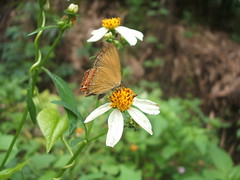
Contending arguments from the floor included the view that the completed reservoir could create an even more diverse and beautiful environment than that which would be submerged, and the insistence by one participant that he had never seen a Fairy Pitta( Pitta nympha) in the area. (Long term scientific surveys show that the area is an important breeding habitat for this bird.)
One additional area of concern raised was that local people appeared to be under the impression that the reservoir construction would be accompanied be tourism, therefore bringing economic benefits to the local area. When asked to clarify, Yang stated that tourism would indeed not be allowed within the vicinity of the reservoir in order to safeguard water quality, but that it would be allowed to occur in areas some distance from the reservoir.
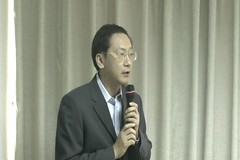
He Dongji explains the current
conservation measures.
The meeting concluded with an effort to finalise the items for discussion at the official hearing, as well as several procedural issues. The following items were agreed upon:
Procedural issues:
1. The official hearing would be postponed to allow the hearing to achieve its anticipated results, date to be announced on the WRA website http://www.wracb.gov.tw (now set for 26 April).
2. The Central Region Water Resources Office should make current research and information related to implementation of the project available on the WRA website.
3. There should be full communication between the government and the public regarding water resources development policy, promotion and execution, and an effective dialogue system should be established to help in the drafting and implementation of public policy, such as through public hearings.
4. The executive agent [i.e. the CRWRO] should take note of and respond to all opinions that were not listed as points of contention.
Issues to be addressed in the hearing on April 26:
1. Conservation
1.1 Whether the timescale and order of the conservation measures are logical.
1.2 Whether the research timescale and fees are appropriate and whether their results can be responded to in the conservation measures.
1.3 Whether the plant and animal relocation program will meet its planned objectives given that no research has been carried out in the area to which species are to be relocated.
1.4 Whether the conservation measures are only focused on species conservation, not on ecosystem conservation.
1.5 Whether the success of the conservation measures can be verified given the lack of baseline data, and whether the environmental conditions and conservation activities will make the conservation program workable.
1.6 Whether You-cing Valley is irreplaceable and what conservation measures are planned for the Valley.
1.7. Whether the dam will influence the watershed ecology of the Cing-shuei River and how conservation measures will be implemented for that river.
2.Water resources
2.1 How water resources are to be exploited in the Yunlin region.
2.2 The relationship between the Hushan Reservoir and land subsidence.
2.3 The influence of extraction of water for the Hushan Reservoir on the water resources of the Cing-shuei River.
The hearing will be held on 26 April 2008 in Douliu Town Hall, Yunlin County.
More Hushan news at Stop Hushan Dam! Blog, the blog of the Taiwan National Coalition Against the Hushan Dam.
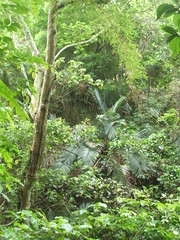
The Hushan area.
1The Central Region Water Resources Office, Water Resources Agency, Ministry of Economic Affairs.
2Assistant Professor in the Department of Land Management at Feng-chia University.
3Deputy Director of the Water Resources Agency of the Ministry of Economic Affairs.
4President of Environment and Animal Society of Taiwan (EAST).